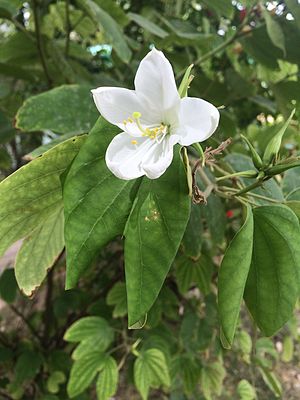Note: This is a project under development. The articles on this wiki are just being initiated and broadly incomplete. You can Help creating new pages.
Difference between revisions of "Bauhinia acuminata"
| Line 53: | Line 53: | ||
==How to plant/cultivate== | ==How to plant/cultivate== | ||
Succeeds in full sun to partial shade. Prefers a fertile, well-drained but moisture-retentive soil.<ref name="How to plant/cultivate"/> | Succeeds in full sun to partial shade. Prefers a fertile, well-drained but moisture-retentive soil.<ref name="How to plant/cultivate"/> | ||
| + | |||
| + | ==Season to grow== | ||
| + | <ref name="Season to grow"/> | ||
| + | |||
| + | ==Required Ecosystem/Climate== | ||
| + | Grows best in a sunny position[ 200 , 652 ]. Prefers a fertile, moisture-retentive but well-drained, sandy, loamy or gravelly soil.<ref name="Required Ecosystem/Climate"/> | ||
| + | |||
| + | ==Kind of soil needed== | ||
| + | Requires rich well drained soil.<ref name="Kind of soil needed"/> | ||
==Commonly seen growing in areas== | ==Commonly seen growing in areas== | ||
| Line 71: | Line 80: | ||
<ref name="Leaf">[Morphology]</ref> | <ref name="Leaf">[Morphology]</ref> | ||
<ref name="How to plant/cultivate">[http://tropical.theferns.info/viewtropical.php?id=Bauhinia+acuminata Cultivation]</ref> | <ref name="How to plant/cultivate">[http://tropical.theferns.info/viewtropical.php?id=Bauhinia+acuminata Cultivation]</ref> | ||
| + | |||
| + | <ref name="Kind of soil needed">[https://www.indiaplants.com/plant-details.php?x=URDhiAYeJlM= Kind of soil needed]</ref> | ||
| + | |||
| + | <ref name="Required Ecosystem/Climate">[https://pfaf.org/user/Plant.aspx?LatinName=Bauhinia+purpurea Required Ecosystem/Climate]</ref> | ||
| + | <ref name="Leaf">[Morphology]</ref> | ||
</references> | </references> | ||
Revision as of 17:40, 3 November 2020
Dwarf white bauhinia is a shrub. It grows up to 3 metres tall. The plant is harvested from the wild for local medicinal use. It is often cultivated as an ornamental and hedge plant in the tropics.
Contents
- 1 Uses
- 2 Parts Used
- 3 Chemical Composition
- 4 Common names
- 5 Properties
- 6 Habit
- 7 Identification
- 8 List of Ayurvedic medicine in which the herb is used
- 9 Where to get the saplings
- 10 Mode of Propagation
- 11 How to plant/cultivate
- 12 Season to grow
- 13 Required Ecosystem/Climate
- 14 Kind of soil needed
- 15 Commonly seen growing in areas
- 16 Photo Gallery
- 17 References
- 18 External Links
Uses
Acne, Sores, Pimples, Cancer, Diabetes, Thoat infections.
Parts Used
Chemical Composition
Phytochemical screening of leaves yielded starch, alkaloids, flavonoids, tannins, reducing sugars, amino acids, and lignins.[1]
Common names
| Language | Common name |
|---|---|
| Kannada | Kanchan |
| Hindi | Safed Kachnar |
| Malayalam | Mandaaram |
| Tamil | Vellai mandaarai |
| Telugu | NA |
| Marathi | NA |
| Gujarathi | NA |
| Punjabi | NA |
| Kashmiri | NA |
| Sanskrit | Sivamalli |
| English | Dwarf white orchid tree |
Properties
Reference: Dravya - Substance, Rasa - Taste, Guna - Qualities, Veerya - Potency, Vipaka - Post-digesion effect, Karma - Pharmacological activity, Prabhava - Therepeutics.
Dravya
Rasa
Guna
Veerya
Vipaka
Karma
Prabhava
Habit
Identification
Leaf
| Kind | Shape | Feature |
|---|---|---|
Flower
| Type | Size | Color and composition | Stamen | More information |
|---|---|---|---|---|
| {{{5}}} |
Fruit
| Type | Size | Mass | Appearance | Seeds | More information |
|---|---|---|---|---|---|
Other features
List of Ayurvedic medicine in which the herb is used
Where to get the saplings
Mode of Propagation
How to plant/cultivate
Succeeds in full sun to partial shade. Prefers a fertile, well-drained but moisture-retentive soil.[3]
Season to grow
Required Ecosystem/Climate
Grows best in a sunny position[ 200 , 652 ]. Prefers a fertile, moisture-retentive but well-drained, sandy, loamy or gravelly soil.[5]
Kind of soil needed
Requires rich well drained soil.[6]
Commonly seen growing in areas
Dry dipterocarp forest in monsoon regions, Well-drained and sunny places, Dry dipterocarp forests.
Photo Gallery
References
- ↑ Chemical constituents
- ↑ [Morphology]
- ↑ Cultivation
- ↑ Cite error: Invalid
<ref>tag; no text was provided for refs namedSeason to grow - ↑ Required Ecosystem/Climate
- ↑ Kind of soil needed
External Links
- Pages with reference errors
- Ayurvedic Herbs known to be helpful to treat Acne
- Ayurvedic Herbs known to be helpful to treat Sores
- Ayurvedic Herbs known to be helpful to treat Pimples
- Ayurvedic Herbs known to be helpful to treat Cancer
- Ayurvedic Herbs known to be helpful to treat Diabetes
- Ayurvedic Herbs known to be helpful to treat Thoat infections
- Herbs with Flowers used in medicine
- Herbs with Leaves used in medicine
- Herbs with Roots used in medicine
- Herbs with common name in Kannada
- Herbs with common name in Hindi
- Herbs with common name in Malayalam
- Herbs with common name in Tamil
- Herbs with common name in Sanskrit
- Herbs with common name in English
- Habit - Shrub
- Index of Plants which can be propagated by Seeds
- Herbs that are commonly seen in the region of Dry dipterocarp forest in monsoon regions
- Herbs that are commonly seen in the region of Well-drained and sunny places
- Herbs that are commonly seen in the region of Dry dipterocarp forests
- Herbs
- Pages without herbs images





